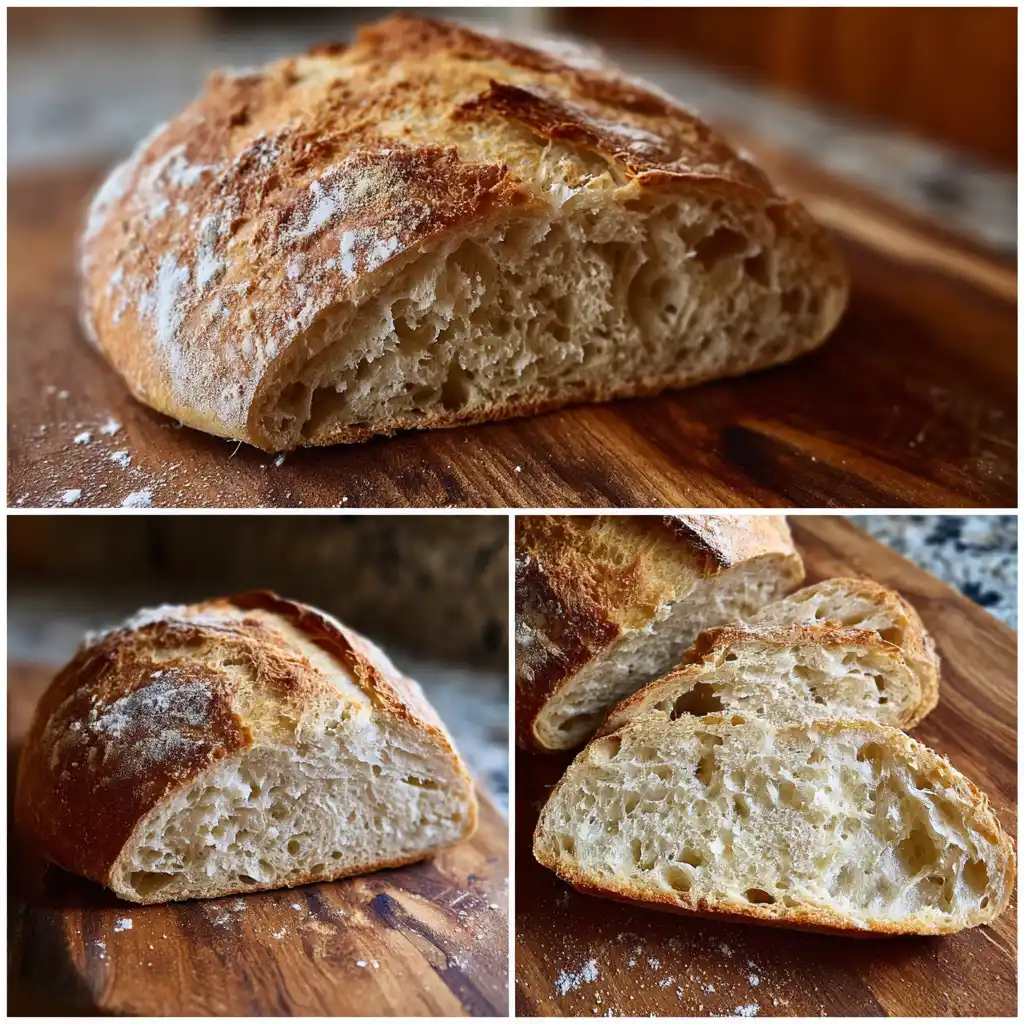Have you ever wondered why some homemade breads come out beautifully crusty and airy without the need for endless kneading or complex steps? The Miracle No-Knead Bread is transforming kitchens worldwide by proving that baking artisan-quality bread can be simple and foolproof. Backed by baking science and beloved by home bakers and professionals alike, this recipe challenges the traditional belief that good bread requires hours of kneading.

Ready to discover how to create perfect loaves with minimal effort? Let’s dive into the secrets behind this no-fuss bread-making marvel.
Ingredients List
To bake your perfect Miracle No-Knead Bread, gather the following ingredients:
- 3 cups (360 grams) all-purpose flour or bread flour for a sturdy yet tender crumb
- 1 ½ cups (360 ml) warm water think slightly warmer than room temperature for optimal yeast activation
- 1 teaspoon salt to enhance flavor and strengthen the dough structure
- ½ teaspoon active dry yeast (or instant yeast) the magic behind your dough’s rise
Optional substitutions:
- Swap all-purpose flour with whole wheat or spelt flour for a nuttier, more robust taste.
- Use sea salt or Himalayan pink salt for subtle mineral notes.
- Try honey or maple syrup (1 tablespoon) instead of white sugar to boost yeast activity naturally and add depth.
- For gluten-free options, experiment with a blend of gluten-free flours but expect different textures and longer proofing times.
These simple ingredients combine to create a dough that ferments slowly, developing flavor and bakery-worthy texture without any kneading.
Timing
The beauty of the Miracle No-Knead Bread lies in its effortless timeline:
- Preparation time: 10 minutes to mix ingredients no kneading required
- First rise: 12 to 18 hours at room temperature slow fermentation is key here
- Baking time: 30 to 40 minutes
- Total time: Around 13 to 18 hours, but only 10 hands-on minutes
Compared to traditional bread recipes that require 90 to 120 minutes of active kneading and multiple rises, this method saves both effort and provides a richer flavor through slow fermentation.
Step-by-Step Instructions
Step 1: Mix Your Ingredients
In a large mixing bowl, combine flour, salt, and yeast. Slowly pour in warm water and stir with a wooden spoon until a shaggy dough forms. Don’t overthink it; the dough will be sticky and loose that’s exactly what you want for an open crumb.
Tip: Use a digital kitchen scale for precise flour measurement. If the dough feels too dry, add a splash more water; too wet, add a pinch of flour.
Step 2: Let the Dough Rest and Rise
Cover the bowl with plastic wrap or a clean kitchen towel and leave it on the counter for 12 to 18 hours. During this slow fermentation, natural yeast activity develops deep, complex flavors and a delightful texture. The dough will bubble and double in size.
Tip: Room temperature between 68°F to 75°F is ideal. If your kitchen is colder, extend the rising time.
Step 3: Shape the Dough
Lightly flour your work surface and gently scrape the dough out from the bowl. Using floured hands, fold the dough over itself a couple of times to create surface tension no heavy kneading needed. Shape into a ball.
Tip: Use just enough flour to prevent sticking; too much can toughen the crust.
Step 4: Second Rest
Place the dough seam-side down on a piece of parchment paper and cover it with a towel. Let it rest for 1 to 2 hours until it puffs up noticeably.
Step 5: Bake to Perfection
Preheat your oven to 450°F (230°C) with a Dutch oven or heavy lidded pot inside for at least 30 minutes. Carefully transfer your dough (on parchment) into the hot pot, cover, and bake for 30 minutes. Remove the lid and bake for an additional 10 to 15 minutes to crisp the crust.
Tip: The sealed environment traps steam to create that coveted crusty exterior. For extra crunch, you can spray a little water inside the oven right after removing the pot lid.
Nutritional Information
One medium loaf of Miracle No-Knead Bread (approx. 12 slices) contains:
- Calories: ~190 per slice
- Carbohydrates: 35 grams
- Protein: 6 grams
- Fat: 1 gram
- Fiber: 2 grams
- Sodium: 350 mg
This bread strikes a balance between simplicity and nourishment, providing an excellent source of wholesome carbohydrates and moderate protein. Slow fermentation enhances nutrient availability, making it easier on digestion compared to quick-rise breads.
Healthier Alternatives for the Recipe
To boost nutrition without compromising taste:
- Substitute 1 cup of all-purpose flour with whole wheat flour for extra fiber and micronutrients.
- Add 2 tablespoons of ground flaxseed or chia seeds to the dry ingredients for heart-healthy omega-3s.
- Experiment with natural sweeteners like molasses or date syrup to add antioxidants.
- For lower sodium, reduce salt to ¾ teaspoon and enhance flavor with herbs like rosemary or garlic powder.
These tweaks keep your Miracle No-Knead Bread both delicious and health-conscious.
Serving Suggestions
Enjoy your Miracle No-Knead Bread warm with:
- Classic butter and a drizzle of local honey for breakfast bliss.
- Avocado smash and cherry tomatoes sprinkled with sea salt for a trendy snack.
- Toasted slices paired with homemade soups such as tomato basil or creamy pumpkin.
- Topped with herb-infused olive oil and a sprinkle of Parmesan for a delightful appetizer.
For family meals, serve alongside salads, stews, or charcuterie boards to elevate your dining experience.
Common Mistakes to Avoid
Home bakers often stumble on these pitfalls:
- Using too much flour: Makes the bread dense instead of light and airy. Always measure carefully.
- Skipping the slow rise: Rushing fermentation sacrifices flavor and crumb texture. Patience is your best friend.
- Oven temperature too low: Results in dull crusts; preheat well and use a Dutch oven for ideal conditions.
- Handling dough too roughly: Overworking destroys the bubbles that give airy texture; fold gently.
- Not allowing sufficient proofing time in step two: An under-proofed dough yields a heavy loaf.
Avoiding these mistakes ensures success every time you make Miracle No-Knead Bread.
Storing Tips for the Recipe
To maintain freshness:
- Store your bread in a paper bag or bread box at room temperature for up to 3 days. Plastic bags can trap moisture and soften the crust.
- For longer storage, slice and freeze the bread in airtight bags for up to 3 months. Toast slices directly from frozen for convenience.
- To refresh day-old bread, sprinkle lightly with water and warm briefly in the oven to restore crispness.
Prepping dough a day ahead or freezing shaped dough before the final rise are also great ways to save time without sacrificing quality.
Conclusion
The Miracle No-Knead Bread offers an approachable, science-backed approach to artisan bread baking minimal effort, maximum flavor, and a stunning loaf every time. From simple ingredients to foolproof techniques, it defies the notion that great bread demands hours of kneading. Try this recipe today, and join thousands of home bakers rediscovering the joy of fresh, crusty, homemade bread. Share your baking success stories or questions in the comments and explore our other easy bread recipes for more delicious inspiration!
FAQs
Q1: Can I use instant yeast instead of active dry yeast?
Absolutely! Instant yeast works well and doesn’t require proofing. Just mix it directly with the flour.
Q2: What happens if I let the dough rise longer than 18 hours?
The dough can become over-fermented, developing a sour taste and weakening its structure, so try not to exceed 18 hours.
Q3: Can I bake Miracle No-Knead Bread without a Dutch oven?
Yes, but a heavy covered pot traps steam crucial for crust formation. Without it, place a pan of hot water in the oven to create steam.
Q4: How do I make gluten-free Miracle No-Knead Bread?
Use a gluten-free flour blend designed for bread and add xanthan gum for elasticity. Expect a denser texture and adjust hydration accordingly.
Q5: Is it possible to add herbs or seeds to the dough?
Definitely. Fold in fresh or dried herbs, sesame seeds, or sunflower seeds during mixing for extra flavor and texture.
Want to deepen your bread-baking skills? Check out our guides on sourdough starter care and mastering bread scoring for amazing results!


Leave a Reply